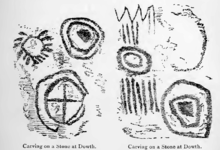Dowth
|
Aerial view of Dowth | |
 Shown within Ireland | |
| Location | valley of the River Boyne |
|---|---|
| Region | County Meath, Ireland |
| Coordinates | 53°42′13″N 6°27′01″W / 53.70365°N 6.4502°W |
| Type | passage grave |
| Part of | Brú na Bóinne |
| History | |
| Periods | Neolithic |
| Type | Cultural |
| Criteria | i, iii, iv |
| Designated | 1993 (17th session) |
| Part of | Brú na Bóinne - Archaeological Ensemble of the Bend of the Boyne |
| Reference no. | 659 |
| Ireland | |
| Region | Europe and North America |
| Official name | Dowth Mound & Dowth Passage Tomb |
| Reference no. | 410 & 652 |
Dowth (Irish: Dubhadh) is a Neolithic passage tomb located in the Boyne Valley, County Meath, Ireland that dates from about 2,500 – 2000 BC. [1] It is the second oldest behind Newgrange of the three principal tombs of the Brú na Bóinne World Heritage Site – a landscape of prehistoric monuments including the large passage-tombs of Dowth, Newgrange and Knowth). It is less developed as a tourist attraction than its neighbours, partly because the chamber is much lower, and partly because the decoration is poorer. It was partly excavated in 1847, though it was pillaged by Vikings and earlier looters long before that.
Description
The cairn or tumulus is about 85 metres (280 ft) in diameter and 15 metres (50 ft) high,[1] and surrounded by large kerbstones, some of which are decorated. Quartz was found fallen outside the kerbing, suggesting that the entrance to this tomb was surrounding by glittering white, as at Newgrange. Three stone-lined passages lead into the mound from the west.
The long passage is crossed by 3 sill-stones and ends in a cruciform chamber with a lintelled (not corbelled as in Newgrange or Knowth) roof. Several of the orthostats (upright stones) of the passage and chamber are decorated with spirals, chevrons, lozenges and rayed circles. On the floor stands a single stone basin — somewhat the worse for wear after 5,000 years. The right-hand arm of the cross leads into another long rectangular chamber with an L-shaped extension entered over a low sill. This may be the earliest part of the tomb, later brought within the design of the cruciform tomb. It is floored with a 2.4 metre-long flagstone containing an oval bullaun (artificial depression). Until recently the cruciform tomb was reached by climbing down a ladder in an iron cage, and crawling about over loose stones. Now, access is restricted, and all the features are guarded by metal grilles.
A kerbstone with cup-marks, a spiral and a flower-like design marks the entrance to the second, smaller tomb — with modern concrete roof. This tomb has a few decorated stones, and a single, massive right-hand recess.
At the entrance to the passage of the cruciform tomb is an early Christian souterrain.[1]

Astronomical alignment
Dowth shares a special solar celebration with neighbouring Newgrange during the winter solstice. Martin Brennan, author of The Stars and the Stones: Ancient Art and Astronomy in Ireland - Thames and Hudson 1983,[2] discovered the remarkable alignment during the course of his ten-year study in the Boyne Valley. From November to February the rays of the evening sun reach into the passage and then the chamber of Dowth South. During the winter solstice the light of the low sun moves along the left side of the passage, then into the circular chamber, where three stones are lit up by the sun.
The convex central stone reflects the sunlight in to a dark recess, lighting up the decorated stones there. The rays then recede slowly along the right side of the passage and after about two hours the sun withdraws from Dowth South.
References
External links
| Wikimedia Commons has media related to Dowth. |